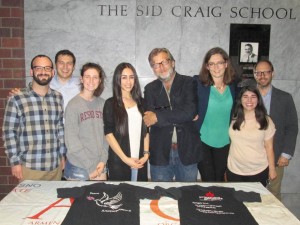
Photo: Barlow Der Mugrdechian
Michael Rettig
Editor
The Armenian Genocide prompted one of the largest humanitarian aid campaigns in American history. The American Committee for Relief in the Near East spearheaded this effort to alleviate the sufferings of the Armenian people. Dr. Keith Watenpaugh (UC Davis), in his lecture “The Drowned, the Saved, and the Forgotten: Genocide and the Foundations of Modern Humanitarianism,” on Tuesday, April 4, argued that the Armenian Genocide marked a monumental shift in how humanitarian aid was conducted.
Whereas prior humanitarian work was primarily carried out by religious organizations, the American response to the Armenian Genocide was the first widespread secular relief project. This lecture concluded the day-long Symposium for Syrian Refugees, sponsored by the Islamic Studies Speaker Series, the Department of History, the College of Social Sciences, and the Armenian Studies Program.
According to Dr. Watenpaugh, the Rockefeller Foundation was one of the most influential humanitarian organizations in addressing the sufferings of WWI victims.
Employees of the Rockefeller Foundation quickly realized that the sufferings of the Armenians were not the typical war time casualties that they were accustomed to aiding.
“As early as the fall of 1915, Western relief workers understood that what was happening to the Armenians was unique and unprecedented in the scope of humanitarian action,” said Dr. Watenpaugh.
Dr. Watenpaugh stressed that it is also important to consider how the Armenians themselves viewed the situation of the refugees.
When the Armenians of Musa Dagh were saved and taken to Port Said, they were forced to reside in what Dr. Watenpaugh described as “the first modern refugee camp.” Armenians referred to these refugees as “shipwrecked.”
They were different from the victims of prior massacres because they were torn from their native environment and utterly helpless without outside intervention.
Dr. Watenpaugh noted that reports from Rockefeller aid workers to America inspired activists to take a more aggressive humanitarian response to address the needs of the Armenians.
The American Committee for Relief in the Near East was founded in response to the Genocide and began a campaign to raise funds for the Armenian victims. According to Dr. Watenpaugh, the Near East Relief did not focus on raising money in traditional avenues, such as churches or religious organizations.
Rather, they took a more modern secular business-oriented approach to humanitarianism by using propaganda posters and advertisements, thereby raising more money than any other organization.
One poster depicts a refugee girl with outstretched arms appealing to the reader for help, with the caption: “Lest We Perish.” Dr. Watenpaugh stressed that the aid workers from Near East Relief were not missionaries, but doctors, professionals, and veterans.
In conducting his research, Dr. Watenpaugh noticed that the Armenians often “disappeared into a faceless mass.” He was interested in uncovering the voices of Armenian refugees. To accomplish this, Dr. Watenpaugh utilized three memoirs of Armenians who had interacted with the Near East Relief.
One such memoir was Antranig Dzarougian’s Men Without Childhood. Dzarougian faced a difficult life in a Near East Relief orphanage and expressed an understanding that his status as an orphan had damaged him.
“It is a profound reminder of how the dehumanizing elements of genocide continue to be visited on survivors no matter how effective programs of relief could be,” said Dr. Watenpaugh.
Dr. Watenpaugh concluded his lecture by detailing how funding for the Near East Relief eventually declined as the orphans grew older and donor fatigue settled in.
Despite this fact, the Near East Relief was able to successfully mobilize Americans of different faiths and denominations in support of the Armenian refugees, thus laying the foundations for modern humanitarianism.
 Hye Sharzhoom Armenian Action
Hye Sharzhoom Armenian Action